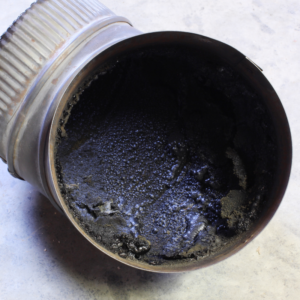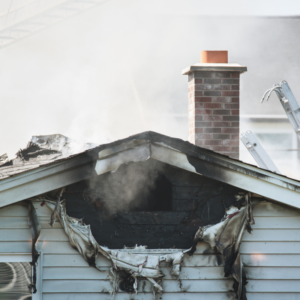Chimney fires are often slow-moving and occur quietly, making them go widely undetected by most homeowners – which is why knowing all the facts about them is a must.
Chimney fires are almost always caused by dirty chimneys, and the buildup that typically triggers them is called creosote or hardened soot. How does creosote cause chimney fires? Well, that’s what the crew here at Holy Smoke is here to talk about.
What Is Creosote?
 Creosote is a combination of byproducts that develop in your chimney when burning firewood in your fireplace. As fumes and smoke move toward the top of the chimney, they cool down, which creates moisture and condensation, causing the byproducts to adhere to walls of your system. The end result is creosote in your flue.
Creosote is a combination of byproducts that develop in your chimney when burning firewood in your fireplace. As fumes and smoke move toward the top of the chimney, they cool down, which creates moisture and condensation, causing the byproducts to adhere to walls of your system. The end result is creosote in your flue.
Creosote is typically brown or black in color, and it can form into a few different textures: tar-like and sticky, hardened and shiny, or crusty and flaky. Textures vary based on the type of wood burned (seasoned or not) and the length of time smoke lingers inside the chimney,
When spotted early, creosote can be easy to remove by a professional with a chimney sweeping. But as time goes by and buildup is ignored, it can harden and form a glazed texture – this type takes time, and sometimes special chemicals, to remove.
What Are the Kinds of Creosote?
The kinds of creosote are sorted based on stages of thickness and hazard levels. Note that, regardless of the stage, creosote should be regularly removed.
- First Stage: The first layer of creosote can be removed with a chimney brush and basic tools. At this stage, the creosote buildup is normal – it only means that the chimney is effective in containing smoke and releasing it into the air outdoors. All chimneys will face creosote buildup at some point, and as long as your first stage creosote is regularly removed, all should be fine with your chimney. That said, anything beyond this is problematic.
- Second Stage: At this point, you will notice a thicker buildup. This will typically consist of hard or sticky tar and dry flakes in your flue lining. Brushing can become more difficult, requiring speciality tools to remove the buildup. Second stage creosote can block outgoing smoke and heat in the chimney, leading to poor airflow, fire hazards, and other issues.
- Third Stage: This is an alarming stage where a chimney fire could happen at any point. Third stage creosote often forms in uninsulated chimneys, low-temperature wood stoves, oversized flues, systems with poor airflow, and after using unseasoned wood. The creosote during this stage will look hard and glossy or shiny. It could also look like tar running down the walls of the chimney with the hardened patches of creosote throughout.
How Does Creosote Create Chimney Fires?
 Aside from the fact that creosote can damage the flue lining over time through corrosion, it is also highly combustible. Every form of creosote is flammable since it’s made up of unburned wood particles or byproducts. The more creosote you have, the higher your risk is of experiencing a chimney fire. That said, it’s worth noting that any amount of creosote can cause chimney fires.
Aside from the fact that creosote can damage the flue lining over time through corrosion, it is also highly combustible. Every form of creosote is flammable since it’s made up of unburned wood particles or byproducts. The more creosote you have, the higher your risk is of experiencing a chimney fire. That said, it’s worth noting that any amount of creosote can cause chimney fires.
A chimney’s flue lining and masonry are constructed to endure certain levels of heat, but not direct contact with a fire. And while one would think that a chimney is supposed to contain a fire, it does not. Smoke is released through chimneys – not fire.
Overexposure to fire may cause a chimney to crack, expand, then possibly explode. The fire could then spread rapidly to other parts of the house. Aside from this worst-case scenario, creosote also causes detrimental health issues such as respiratory problems, eye and skin irritation, and more.
How Do I Prevent Creosote Buildup?
While creosote isn’t able to be avoided altogether, there are ways for you to prevent excess buildup:
- Only Burn Seasoned Dry Firewood: Freshly cut wood contains a lot of moisture that, which results in acidic water pouring into your chimney and expedites the production of creosote. Allowing wood to dry for at least six months will allow it to produce less smoke and moisture when burned.
- Make Hot, Clean-Burning Fires: Place firewood together at a small gapped distance to allow air to circulate properly and produce cleaner – and hotter-burning – fires. Making your fires this way can cause lower emissions of smoke in the flue, reducing the buildup of soot and creosote.
- Warm Up Your Flue: Venting up a cooler flue can create higher levels of condensation and trigger more creosote buildup. Make sure to warm the chimney up first by rolling and lighting a newspaper, then holding up up inside of your chimney for several seconds until the airflow reverses. This also helps to minimize smoke backing up into your home when fires are lit.
- Schedule a Chimney Inspection & Sweeping: One of the most effective way to avoid chimney fires is to schedule regular chimney inspections and sweepings with a certified sweep. In fact, inspections should be performed annually, before the start of your burning season. These allow your sweep to check on creosote deposits, look for blockages, and note any other hazardous conditions throughout your chimney.
Is Your Chimney Safe for Use?
Fall is right around the corner, which means your system is bound to see more use throughout the holiday season. Now that you know all the vital facts on creosote and chimney fires, contact a certified chimney sweep to ensure that your chimney is in tiptop shape for the upcoming months ahead.
Reach out to our crew to set up your appointment. Call 530-841-1841 or request your spot online today!

Recent Comments